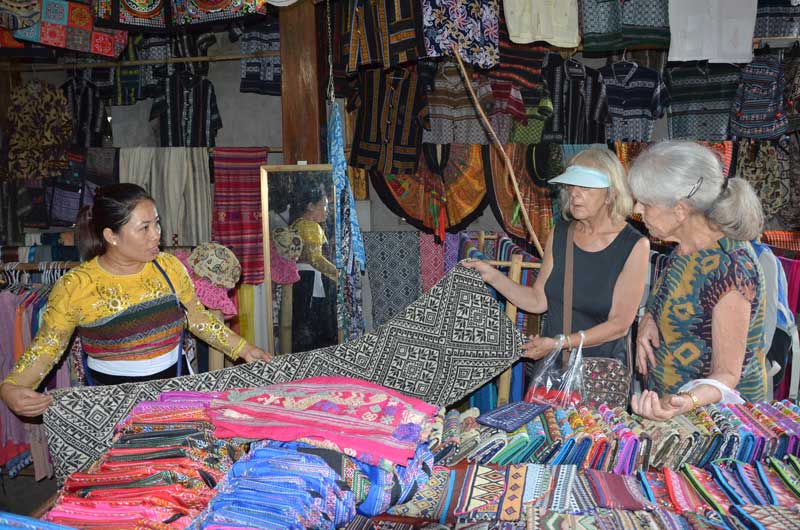
(HBO) - Implementing the Program of one product per commune (OCOP), Mai Chau district directed communes and towns to build typical products.
 Brocade weaving products of Chieng Chau cooperative (Mai Chau district) are popular with foreign tourists.
Brocade weaving products of Chieng Chau cooperative (Mai Chau district) are popular with foreign tourists.
In the 2019-2020 period, the district registered 7 products belonging to 3 product groups. They are fruits and vegetables of Tam Hoa Cooperative in Tam Hoa hamlet, Tan Son commune; consumption market in shops and supermarkets in Hanoi capital. Mai Ha wine, consumption market in the district, inside and outside Hoa Binh province. Phuc San taro of the interest group in the same commune planted and consumed mainly inside and outside the district. Purple garlic is located in Pu Bin and Noong Luong communes, which is grown by households and consumed inside and outside the district. Da river fish of interest group in Phuc San commune; consumption market inside and outside Hoa Binh province.
Souvenir products include brocade weaving products of brocade weaving cooperatives and Chieng Chau tourism services; domestic and export markets.
The rural tourism service group has Lac village homestay tourism product of the Lac village tourism and cooperative service. The cooperative specializes in serving domestic and foreign tourists.
In addition to the above 7 products, the District People's Committee guides communes and towns to select typical products and submit them to the competent authorities for evaluation and ranking in subsequent years.
Based on the registered products, Mai Chau district has 4 products on the list of products participating in OCOP program of Hoa Binh Province in 2019, including: brocade weaving products of Chieng Chau Cooperative; Mai Ha wine products of Mrs. Ha Thi Ton in Chieng Ha hamlet, Mai Ha commune; organic vegetable products of Tam Hoa agricultural service Cooperative in Tan Son Commune; Lac hamlet homestay tourism product of Cooperative service for agriculture, forestry and tourism in Lac hamlet. In which, there are 2 products supported to implement OCOP product standard point in 2019: brocade weaving and homestay tourism in Lac hamlet, Chieng Chau commune.
According to data from the Hoa Binh Provincial Party Committee, the industrial production index for the first six months of 2025 is estimated to have increased by 20% compared to the same period last year. This marks the highest year-on-year growth rate for this period since 2020.
In the first six months of 2025, Hoa Binh province’s export turnover was estimated at 1.145 billion USD, marking an 18.11% increase compared to the same period in 2024. Import turnover was estimated at $ 804 million, a 17.15% increase, which helped the province maintain a positive trade balance.
The lives of the ethnic minority farmers in Tan Lac district have gradually improved thanks to the new directions in agricultural production. This is a testament to the collective strength fostered through the professional associations and groups implemented by various levels of the district’s Farmers’ Union.
With the motto the "product quality comes first,” after nearly one year of establishment and operation, Muong village’s Clean Food Agricultural and Commercial Cooperative, located in Cau Hamlet, Hung Son Commune (Kim Boi district), has launched reputable, high-quality agricultural products to the market that are well-received by consumers. The products such as Muong village’s pork sausage, salt-cured chicken, and salt-cured pork hocks have gradually carved out a place in the market and they are on the path to obtaining the OCOP certification.
In the past, the phrase "bumper harvest, rock-bottom prices" was a familiar refrain for Vietnamese farmers engaged in fragmented, small-scale agriculture. But today, a new spirit is emerging across rural areas of Hoa Binh province - one of collaboration, organisation, and collective economic models that provide a stable foundation for production.
Maintaining growing area codes and packing facility codes in accordance with regulations is a mandatory requirement for agricultural products to be eligible for export. Recently, the Department of Agriculture and Environment of Hoa Binh province has intensified technical supervision of designated farming areas and packing facilities to safeguard the "green passport" that enables its products to access international markets.



 Brocade weaving products of Chieng Chau cooperative (Mai Chau district) are popular with foreign tourists.
Brocade weaving products of Chieng Chau cooperative (Mai Chau district) are popular with foreign tourists.